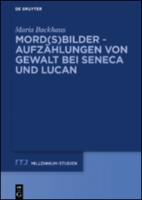Mord(s)bilder - Aufzählungen von Gewalt bei Seneca und Lucan
| dc.contributor.author | Backhaus, Maria | |
| dc.date.accessioned | 2021-12-07T16:15:43Z | |
| dc.date.available | 2021-12-07T16:15:43Z | |
| dc.date.issued | 2019 | |
| dc.identifier | ONIX_20211207_9783110639551_49 | |
| dc.identifier | OCN: 1091666356 | |
| dc.identifier.issn | 1862-1139 | |
| dc.identifier.uri | https://library.oapen.org/handle/20.500.12657/51694 | |
| dc.language | German | |
| dc.relation.ispartofseries | Millennium-Studien / Millennium Studies | |
| dc.subject.classification | thema EDItEUR::D Biography, Literature and Literary studies::DS Literature: history and criticism::DSB Literary studies: general::DSBB Literary studies: ancient, classical and medieval | en_US |
| dc.subject.classification | thema EDItEUR::N History and Archaeology::NH History::NHC Ancient history | en_US |
| dc.subject.other | Visualizability | |
| dc.subject.other | enumeration | |
| dc.subject.other | violence | |
| dc.subject.other | death | |
| dc.title | Mord(s)bilder - Aufzählungen von Gewalt bei Seneca und Lucan | |
| dc.type | book | |
| oapen.abstract.otherlanguage | Often noticed, frequently criticized, the descriptions of physical violence in Seneca’s philosophical work De ira and Lucan’s civil war epic De bello civili irritate until today. Only looking at the theory of rhetoric, the use of exempla and the staging of violence allows an approach to ancient reception attitudes and reveals the connections between enumeration and visualizability, violence and the the arousal of the emotions. | |
| oapen.identifier.doi | 10.1515/9783110639551 | |
| oapen.relation.isPublishedBy | 2b386f62-fc18-4108-bcf1-ade3ed4cf2f3 | |
| oapen.relation.isbn | 9783110639551 | |
| oapen.relation.isbn | 9783110635973 | |
| oapen.relation.isbn | 9783110636390 | |
| oapen.series.number | 76 | |
| oapen.pages | 329 | |
| oapen.place.publication | Berlin/Boston |

